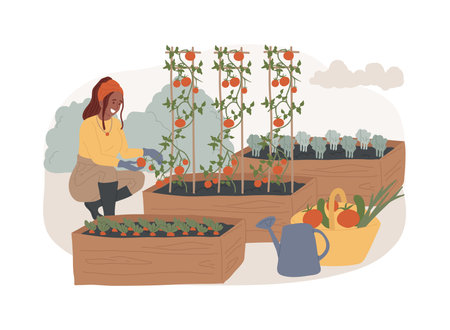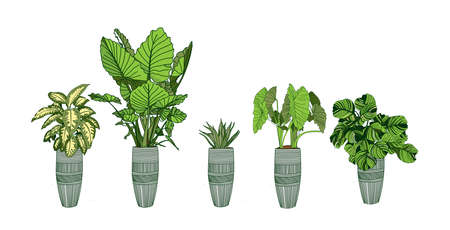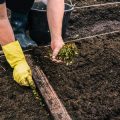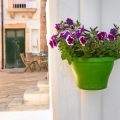Introduction: Embracing Herbal Containers in the UK
There’s something truly special about stepping out into your own garden, balcony, or even a modest windowsill and snipping a handful of fresh herbs to add to tonight’s supper. In the UK, where the weather can be more than a touch unpredictable and outdoor space is often at a premium, growing herbs in containers has become a beloved tradition. This method suits our climate perfectly—containers can be moved to catch precious sunlight or sheltered from those inevitable downpours. For many Britons, the joy of nurturing thyme, mint, or rosemary isn’t just about convenience; it’s a nod to generations past, when homegrown ingredients were both a necessity and a source of pride. Whether you’re in a countryside cottage or an urban flat, cultivating herbs in pots connects us with the land and with age-old practices, all while adding flavour and fragrance to everyday life. Growing your own herbs is more than a hobby—it’s a gentle reminder that nature thrives even in the smallest corners of our homes.
Top Herbs for British Containers
If you’re looking to cultivate a classic British container garden, you’ll want herbs that not only thrive in our unpredictable weather but also bring both flavour and tradition to your home. Over the years, I’ve found certain herbs consistently reliable—some even reminiscent of the kitchen gardens my nan tended. Here’s a rundown of favourites well-suited to containers on patios, balconies, or window ledges across the UK:
| Herb | Growing Notes | Traditional Use |
|---|---|---|
| Rosemary | Prefers sunny spots; drought-tolerant once established; keep soil well-drained. | Classic with roast lamb, potatoes, and breads. |
| Thyme | Loves full sun; compact growth suits small pots; trim regularly to prevent woodiness. | Essential in stews, soups, and stuffing mixes. |
| Mint | Vigorous grower; best kept in its own pot to avoid takeover; partial shade is fine. | Perfect for mint sauce, teas, and summer drinks. |
| Chives | Tolerant of cooler temperatures; needs moist, rich soil; cut leaves often for regrowth. | Lifts salads, potato dishes, and egg recipes. |
| Parsley | Grows well in partial shade; water regularly; slow to germinate but worth the wait. | A garnish favourite and staple in sauces. |
| Sage | Enjoys plenty of sunlight; don’t overwater; prune after flowering to encourage bushiness. | Mainstay in stuffings and hearty British fare. |
Nostalgic Touch: These herbs echo the old British gardens of yesteryear—reliable, aromatic companions that have seasoned generations of meals. By selecting these time-tested varieties for your containers, you carry on a tradition that fits perfectly with our climate and culinary heritage. With just a handful of pots, you can enjoy fresh flavour at your fingertips all year round.

3. Selecting the Right Containers and Positioning
When it comes to growing herbs in British containers, your choice of pots and their placement can make all the difference. Start with containers that have good drainage holes—herbs dislike sitting in waterlogged soil, especially after a classic British downpour. Terracotta pots are a traditional favourite; they allow roots to breathe and add a timeless charm to patios and windowsills, but remember they dry out quicker than plastic or glazed pots, so you’ll need to keep an eye on watering. Go for larger containers if possible, as they hold moisture better and give roots more room to grow, which is particularly handy if you’re mixing several herbs together in a mini herb garden.
For compost, use a free-draining multi-purpose mix—add a little grit or perlite if you want to improve drainage further. Mediterranean herbs like rosemary, thyme, and oregano do best in poorer soils, so don’t be afraid to blend in some horticultural sand for these sun-lovers.
Positioning is just as crucial as your choice of container. Most herbs crave sunshine, so pick the sunniest spot you can find—six hours of direct sunlight is ideal for classics like basil and parsley. However, don’t forget the ever-changing British weather: strong winds or sudden cold snaps can take a toll on tender plants. Placing containers near a south-facing wall offers both warmth and shelter. If you’re in a windier region or have a balcony that catches a breeze, consider grouping pots together or using screens to protect your herbs.
Lastly, keep mobility in mind. The beauty of container gardening is flexibility; if one spot turns out to be too shady or exposed, you can easily move your herbs around to catch more sun or avoid harsh weather. A little observation and adjustment go a long way—just like my gran always said, “Keep your eyes on the sky and your hands in the soil.”
4. Planting and Day-to-Day Care
Step-by-Step: Sowing Seeds or Planting Out Starts
Whether you’re starting from seed or buying young plants from the garden centre, getting your herbs established in British containers is a straightforward affair with the right approach. For seeds, fill your container with a good quality peat-free compost, gently firming it down before sowing seeds thinly on the surface. Lightly cover with a fine layer of compost or vermiculite. If you prefer to start with young plants (often called ‘plugs’), make holes just large enough for the root ball, set them in, and water well. Remember what my granddad used to say: “Mind the roots—disturb them little and they’ll thank you much.” Keep your containers in a sheltered spot until seedlings are robust or plants have settled in.
Watering Wisdom: Keeping Herbs Hydrated
Consistent watering is key for lush, healthy herbs—especially in the unpredictable British climate. Check moisture daily by poking your finger into the soil; if it feels dry an inch below the surface, it’s time to water. Early mornings or late afternoons are best to avoid scorching leaves on hot days. My gran always swore by rainwater collected in a butt, as tap water can sometimes be too harsh for delicate seedlings.
| Herb | Watering Needs | Special Notes |
|---|---|---|
| Basil | Keep soil consistently moist | Avoid splashing leaves to prevent mildew |
| Rosemary | Let soil dry between waterings | Drought tolerant; dislikes soggy roots |
| Mint | Moist but not waterlogged | Thrives with regular attention; can get thirsty in heat |
| Parsley | Regular, even moisture | Wilts quickly if neglected; recovers well when watered promptly |
| Thyme | Sparingly; prefers drier soil | Loves a sunny, well-drained spot—dont overdo it! |
Feeding Your Herbs: When and How Much?
If your compost is fresh and rich, most herbs won’t need feeding for the first month or two. After that, a weak liquid feed every fortnight during the growing season will keep them thriving. Avoid overfeeding—“A little goes a long way,” as old Mrs. Pritchard at the allotment used to remind us. Too much fertiliser can lead to lush leaves but less flavour.
Looking After Their Appearance: Traditional Tips for Healthy Growth
Pinch out tips regularly—especially on basil and mint—to encourage bushiness and prevent legginess. Remove any faded or yellowing leaves promptly to keep plants looking their best and discourage pests. Rotate pots every week or so for even growth if you’re short on sunlight on one side of your patio or windowsill. And remember, a bit of gentle talking never hurt—a touch of attention each day works wonders! As my father always said, “Plants thrive on kindness as much as sunshine.” With these small daily rituals, you’ll have thriving herb containers worthy of any British kitchen.
5. Common Problems and How to Tackle Them
Even the most seasoned gardener will tell you: container herb gardening in Britain comes with its fair share of classic hurdles. Over the years, I’ve seen my fair share of slugs sneaking about after a rainy evening, aphids clustering beneath the mint leaves, and the ever-unpredictable British weather throwing a spanner in the works. Let’s have an honest chat about these common issues and how best to keep your potted herbs thriving through it all.
Slugs and Snails: Persistent Nighttime Nibblers
There’s little more disheartening than discovering your young basil munched overnight. Slugs and snails love the moist conditions our climate provides. A time-tested remedy from my own garden is to sprinkle a ring of crushed eggshells or horticultural grit around each pot—these rough barriers deter the slimy visitors without harming them. For persistent problems, copper tape around containers can work wonders as well. And never underestimate a good evening patrol with a torch!
Aphids: Sap-Sucking Menaces
Aphids are notorious for gathering on tender new shoots, especially in spring and early summer. The gentle old-fashioned approach is to simply squish them between your fingers or give the plant a brisk spray with water to knock them off. Ladybirds are natural predators, so encourage these helpful insects into your garden by planting companion flowers like calendula nearby. If things get out of hand, a homemade solution of diluted washing-up liquid can be lightly sprayed onto affected foliage—just be sure to rinse it off after a day or two.
Erratic Weather: Too Wet, Too Dry, or Both
British weather is famously unpredictable—a sunny spell one minute, drizzle the next. Herbs in containers dry out quicker than those in borders, so check soil moisture daily during hot spells and water thoroughly at the base of plants rather than overhead. On the flip side, if heavy rain persists, ensure pots have proper drainage holes and consider raising them slightly off the ground with pot feet or bricks to prevent waterlogging. In cold snaps, move tender herbs like basil indoors overnight or use fleece covers.
Prevention Is Better Than Cure
The best way to avoid problems is through regular attention—a quick daily glance over your herb pots will catch most issues before they get out of hand. Remove dead leaves promptly, tidy up fallen debris, and keep containers clean. Rotate your pots now and then so all sides receive sunlight evenly. Remember: gardening wisdom is built over seasons; patience and observation are your greatest tools.
Final Thought from a Fellow Gardener
Every herb grower faces setbacks—what matters is how we respond with care and persistence. With these gentle but effective remedies, your British container herbs will stand strong against whatever nature throws their way.
6. Harvesting and Using Your Homegrown Herbs
There’s nothing quite like the satisfaction of snipping fresh herbs from your own containers, knowing they’re at their peak of flavour and goodness. Getting the timing right is key: for most British favourites like mint, chives, rosemary, or parsley, it’s best to harvest in the morning after the dew has dried but before the sun gets too strong. This is when essential oils—and thus flavour—are most concentrated. Use clean, sharp scissors or secateurs to snip stems just above a leaf pair, which encourages bushier growth and prolongs the harvest season.
For annuals such as basil or coriander, regular picking keeps them productive; don’t be shy about pinching off flower buds to prevent bolting and keep those leaves coming. Perennials like thyme and sage can be gently trimmed throughout spring and summer, but avoid heavy harvesting late in the season to allow them to harden up for winter.
If you find yourself with a glut, traditional British methods of preservation come into their own. Air-dry sturdy herbs like rosemary and thyme by hanging small bunches upside down in a cool, dry spot—just as our grandmothers did. For softer leaves like parsley and chives, finely chop and freeze in ice cube trays with a splash of water or oil. This way, you’ll have homegrown flavour on hand even in the depths of winter.
Bringing your harvest into the kitchen is where the magic happens. Toss fresh mint into new potatoes or peas for a classic side dish; add chopped chives to egg sandwiches; sprinkle parsley over fishcakes or stews for a burst of colour and taste. For a soothing cuppa, steep fresh chamomile flowers or lemon balm leaves—an age-old remedy for easing stress before bed.
Don’t forget, these herbs aren’t just culinary delights—they’ve long been treasured in British homes for their healing properties. A simple thyme tea can soothe a sore throat, while sage steeped in hot water makes an effective gargle. Embracing these old-fashioned remedies connects us to generations past who understood the value of their herb gardens far beyond the dinner table.
7. Seasonal Reflections and Year-Round Enjoyment
As the seasons turn in Britain, your herbal containers become more than just practical additions to your home—they evolve into cherished companions through the changing weather and light. There is a special satisfaction in watching mint send up its first shoots in spring or clipping sprigs of rosemary as the days shorten and the air grows crisp. To truly get the most from your herbal containers, it’s worth embracing each season’s rhythms and letting them become part of your daily routine and household traditions.
In spring, as daylight stretches out and temperatures rise, it’s the perfect time for a gentle tidy-up—removing dead growth, refreshing compost, and sowing any new seeds you fancy. Summer is the heyday of growth: herbs like basil, coriander, and chives will thrive with regular watering and harvesting, rewarding you with abundant fresh flavours for salads, teas, and summer suppers enjoyed al fresco. Come autumn, focus shifts to cutting back perennials, drying excess herbs for winter use, and perhaps bringing more tender varieties indoors as a fragrant windowsill display.
Winter doesn’t spell the end of enjoyment; rather, it offers a quieter appreciation. A pot of thyme or sage on the kitchen ledge can brighten up even the greyest day, infusing stews and roasts with warmth. Tending to these pots during colder months is a gentle reminder that life continues—even when nature seems asleep outside. It’s also an opportunity to plan for next year: flipping through seed catalogues over a cuppa or jotting down ideas for new container arrangements.
The joy of herbal containers lies not only in their usefulness but in how they root us in place and season. Whether you’re snipping parsley for Sunday lunch or simply brushing past lavender on your way out the door, these small rituals connect you to nature’s cycle—right at your doorstep or kitchen window. Over time, tending your herb pots becomes second nature; you’ll find yourself developing preferences for certain varieties or discovering new ways to use them in your cooking and self-care routines.
Let these containers become a living part of your British home—a source of pride on the patio or balcony, a conversation starter with neighbours, or even a teaching tool for children curious about where their food comes from. With thoughtful seasonal care and appreciation for their subtle pleasures, herb containers offer year-round rewards far beyond their modest size. They’re a gentle nudge to slow down, notice what’s growing around you, and savour every little harvest—no matter the weather outside.


